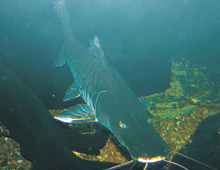Description: The body of the Spotted shovel- nosed catfish is often confused with other catfish when they are young. The top side of their smooth, brownish bodies are covered with vertical bars and rows of black “spots” that become larger and more circular as they age. This “whiskered” catfish has a shovel-like head with small eyes and long barbels.
Size: They can grow to a length of 65 inches (166 cm) and weigh more that 220 pounds (100 kg).
Behavior: Catfish are territorial fish and aggressive toward smaller fish. They are always lurking through murky waters for prey.
Diet: These opportunistic feeders are nocturnal hunters, primarily feeding on fish but they will also eat crustaceans.
Senses: Spotted shovel-nosed catfish rely on chemoreception (response to chemical stimuli – dissolved substances in water- primarily using the senses of taste and smell) for finding prey, avoiding predators, coordinating spawning time and locating fish of their own species. Their entire body is covered with tiny taste buds allowing them to “taste” the waters around them. Close to their nostrils are sensitive olfactory pits giving them the ability to detect food at long distance and also locate prey in water with limited visibility. Their barbells act as antennae and feelers.
Communication: They produce different types of sounds by using their sonic muscles. They have
well developed auditory reception that discriminates between different pitches and velocities.
Reproduction: The migration of these fish is tied to flooding, during which time the spawning season takes place. Females release their eggs close to the water surface; a male or several males will swim above them releasing sperm for fertilization. There is no parental care once the eggs have dispersed.
Habitat/range: These catfish are native to murky water of river basins throughout South America, such as the Amazon and Orinoco.
Status: Not evaluated by the IUCN Red List.



